Sri Lanka, an island country in the Indian Ocean, has a rich and varied cultural heritage dating back millennia. Considering that there are signs of human habitation in Sri Lanka from as early as the sixth century BC, it’s safe to assume that history buffs and culture vultures alike will enjoy seeing the island’s many archaeological sites and cultural landmarks.
Anuradhapura and Polonnaruwa’s ruined temples, Pidurangala Rock’s historic paintings, and the island’s magnificent surrounding seas ensure that visitors of all interests will find something to enjoy in Sri Lanka.
This beautiful country is a natural gem, displaying a wide variety of breathtaking landscapes and a wealth of magnificent sights. To help you make the most of your time in Sri Lanka, we’ve compiled a list of the island nation’s most stunning national parks.
10. Adam’s Bridge Marine National Park

the stunning Adam’s Bridge in Rameswaram, Tamil Nadu, between India and sri lanka. Image source: Svetlana Eremina/Shutterstock.com
Adam’s Bridge Marine National Park offers stunning biodiversity to tourists on a peninsula protruding into the Indian Ocean. A group of low islands called Adam’s Bridge are located inside the marine park; historical records suggest that these islands served as a land bridge between Sri Lanka and India.
It has been famous for a long time; the Ramayana, one of India’s oldest and holiest books, makes reference to it. Given its closeness to India, the network of shoals serves as a significant stopping place for migratory birds traveling north and south.
The park is home to a wide diversity of flora and fauna due to its diverse topography, which includes reefs immediately off the coast, silky beaches, and low-lying scrubland. Even though there are many different kinds of birds that visit the region, the most impressive wildlife visitors can see are dolphins, turtles, and dugongs as they swim down the shore.
9. Kaudulla National Park
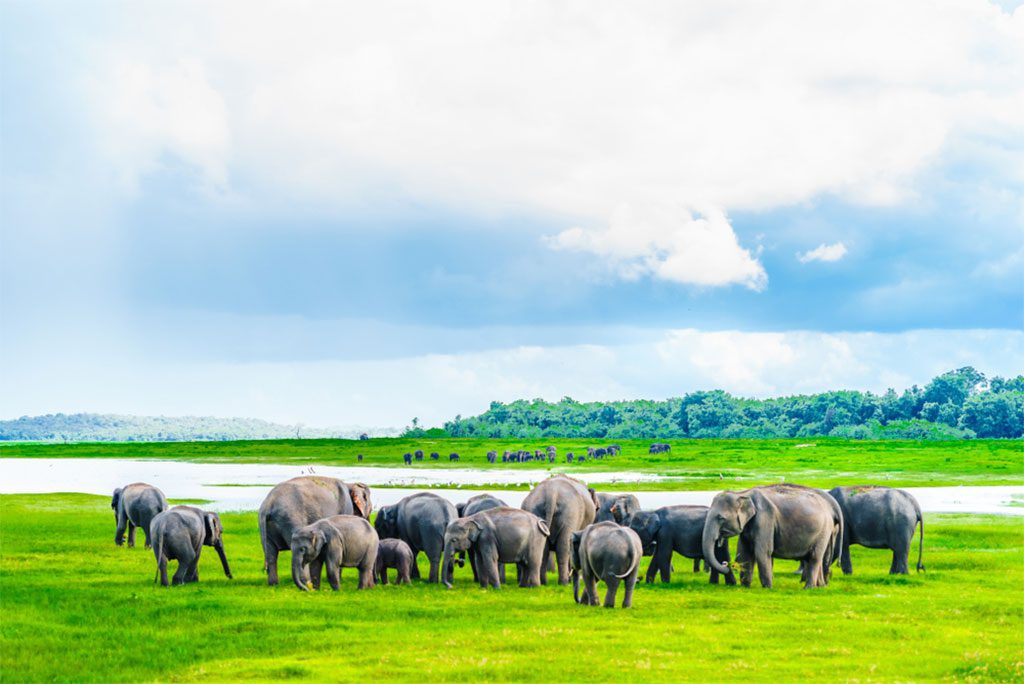
A herd of majestic elephants in Kaudulla National Park, Sri Lanka. Image source: streetflash/Shutterstock.com
This national park is one of the best places to see birds in Sri Lanka, so it’s no surprise that visitors come from all around to see the spectacular display.
Kaudulla is home to a variety of large mammals, but most people go there to see the birds that flit over the clear blue sky. Elephants, sloth bears, Sri Lankan leopards, deer, and wild boar all call these forests home, and lucky visitors could see any of these and more.
When King Mahasen designated the park’s territory as a water supply for his people in the third century AD, he also ensured that the region would be home to an abundance of animals and vegetation, which in turn attracts birds. Sixty years ago, when the irrigation tanks were ultimately abandoned, animals flocked to the region in need of water, and the area was blessedly designated as a national park in 2002. You can see that this beautiful land is replete with historical sites.
8. Gal Oya National Park
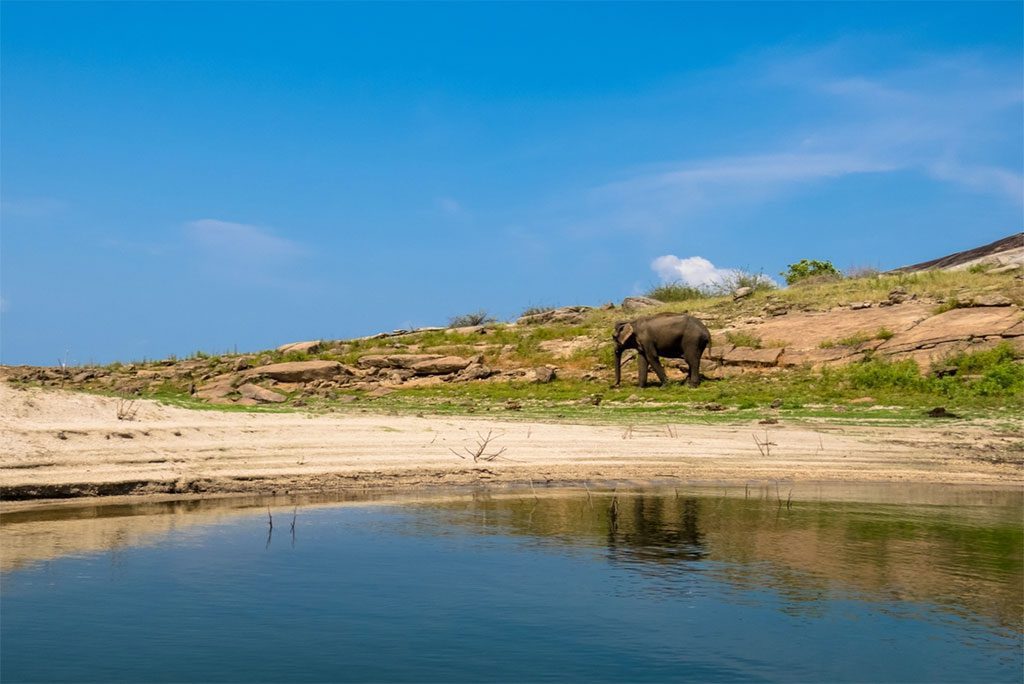
A lone Asian elephant in the beautiful Island Lake landscape of Gal Oya National Park, Sri Lanka. Image source: ThePhotographerSL/Shutterstock.com
Gal Oya National Park was established as a catchment area for the extra water that the nearby Senanayake Samudraya reservoir does not retain, making it a damp and wild environment that is in large part due to the reservoir. For this reason, the national park is home to many wetlands and green forests that gladly drink up the water and transform it into lush foliage and abundant wildlife.
Elephants, buffaloes, and leopards are among the wonderful species that make this park their home. The sacred shrine of Dighavapi, visited by thousands of pilgrims annually, is located next to the park.
7. Kumana National Park
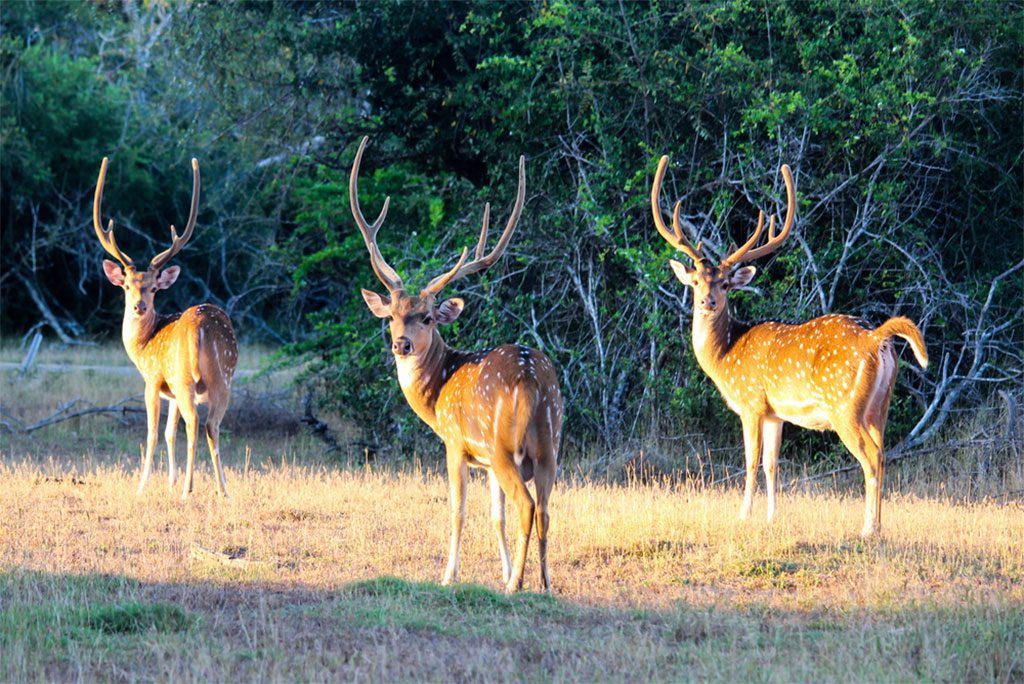
three young spotted deer at Kumana National Park in Sri Lanka. Image source: RandikaSL/Shutterstock.com
Located on the island’s southeastern shore, Kumana National Park provides a safe sanctuary for the many migrating birds that stop here each year. The vast numbers of wading birds and ducks that migrate to the park’s lagoons and wetlands obscure the skyline.
Swamps and forests are scattered throughout the park, providing ideal nesting sites for the region’s impressive bird population (over 250 species have been identified). Birds need to be cautious while resting or eating since jackals and fishing cats wait in the shadows for an easy meal.
There are also occasional sightings of elephants and wild hogs in Kumana. As the ancient and sacred road leading to the Hindu temple of Kataragama passes close to the park’s boundaries, Kumana National Park sees a steady stream of pilgrims throughout the year.
6. Bundala National Park
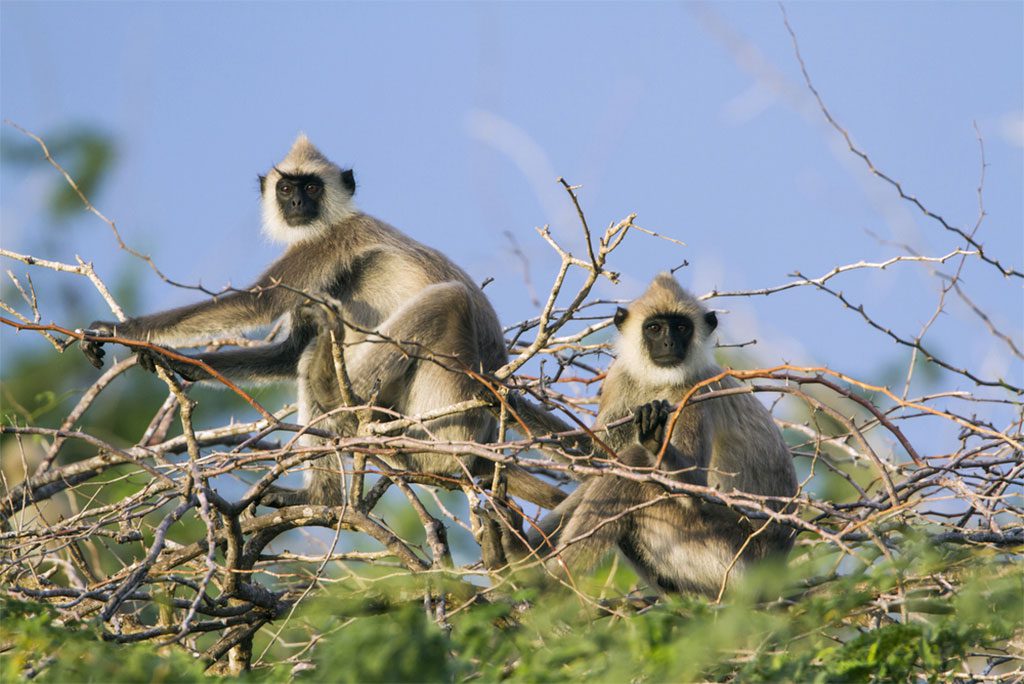
A tufted gray langur in Bundala National Park, Sri Lanka. Image source: PACO COMO/Shutterstock.com
Bundala National Park is home to an astonishing variety of habitats, including wetlands, sand dunes, and forests, and as a result, an equally impressive variety of flora and fauna. There are approximately one hundred species of birds that call Bundala home, and the park also has a wide variety of reptiles and animals.
In the park’s southern region, fortunate visitors may see the elusive Indian muntjac or the easily frightened mouse deer, both of which will quickly disappear into the thick vegetation upon being spotted.
5. Minneriya National Park
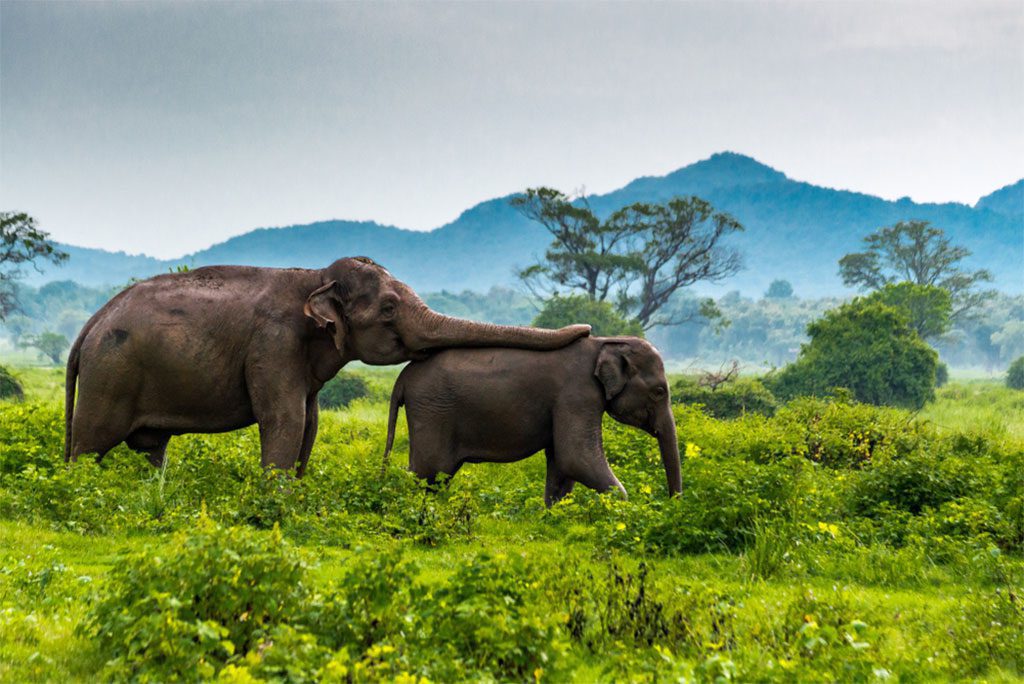
A mother elephant takes care of her baby in the lush green fields of Minneriya National Park, Sri Lanka. Image source: albertodelgadolopez/Shutterstock.com
Not only did King Mahasen’s actions centuries ago create Kaudulla National Park, but they also created Minneriya National Park! The reservoir and wetlands of Minneriya, formerly used as an irrigation tank, are now home to a wide variety of animals and birds.
The park showcases a variety of habitats, from forests to shrublands, so the breathtaking scenery is always changing as you go through it.
Of course, the park’s natural beauty and abundance of animals are major draws, but The Gathering is the undisputed highlight of the whole experience. The grasslands in the park provide an adequate food supply for the Sri Lankan elephants that reside in the surrounding regions during the dry season, attracting herds of these animals to the reservoir’s edge where they can drink and play. The average population is roughly 200, although as many as 700 have reportedly been seen in Minneriya. To see such a massive gathering of elephants in their natural environment is a once-in-a-lifetime opportunity that will leave any fortunate visitor with lasting memories.
4. Wilpattu National Park

A wild sloth bear moves through the rocky terrain of Wilpattu National Park in Sri Lanka. Image source: Ondrej Prosicky/Shutterstock.com
Wilpattu National Park, whose name means “Land of Lakes,” has over sixty lakes. Because of these vital water supplies, a wide variety of plants and animals have made this damp environment their home. The forest and scrubland are home to a wide variety of animals, including elephants, leopards, water buffalo, and the adorable sloth bear.
The untamed beauty of the landscape is stunning since it has not been touched in any way. Visitors will want to come back to Wilpattu National Park again and again to watch the sun go down over the many shades of green, yellow, and brown that make up the park’s landscape.
3. Udawalawe National Park
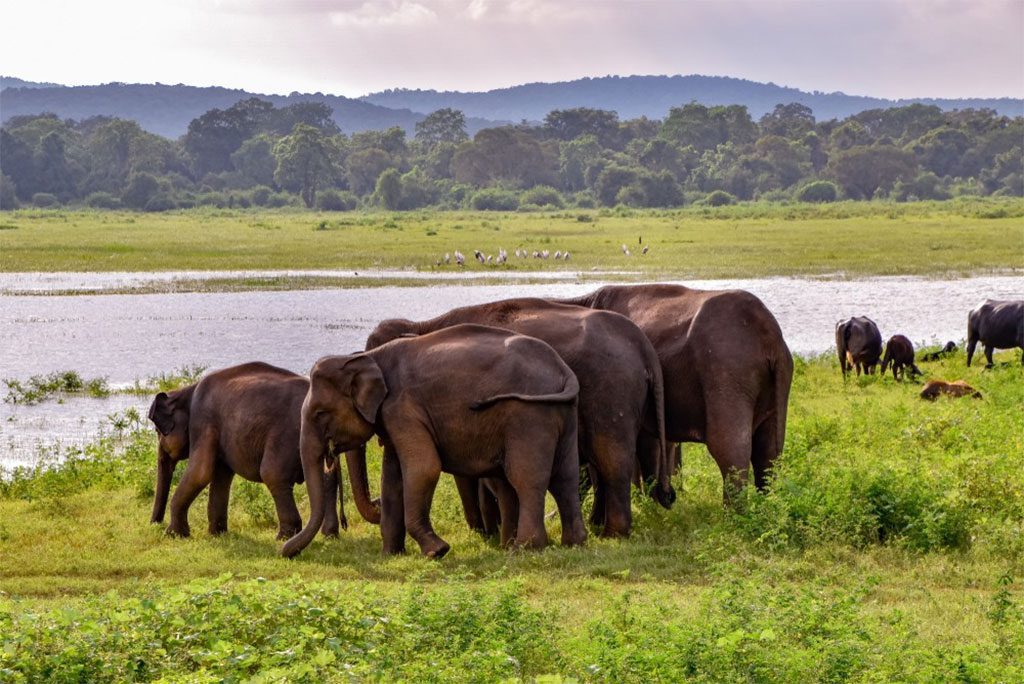
A herd of elephants walk through the lush green forest of Udawalawe National Park in Sri Lanka. Image source: Heinz-Peter Schwerin/Shutterstock.com
Udawalawe National Park is mostly made up of plains and marshes, although there are a few hilly sections that serve as a lovely background to the breathtaking nature on display. The park’s natural appearance is appealing, but the Sri Lankan elephants that wander the flatlands are the major draw for most visitors.
Udawalawe is a sight to see, what with the swooping birds above, the dust that the elephants kick up being a reddish-brown color, and the distant mountains serving as a frame for the whole scene.
2. Horton Plains National Park
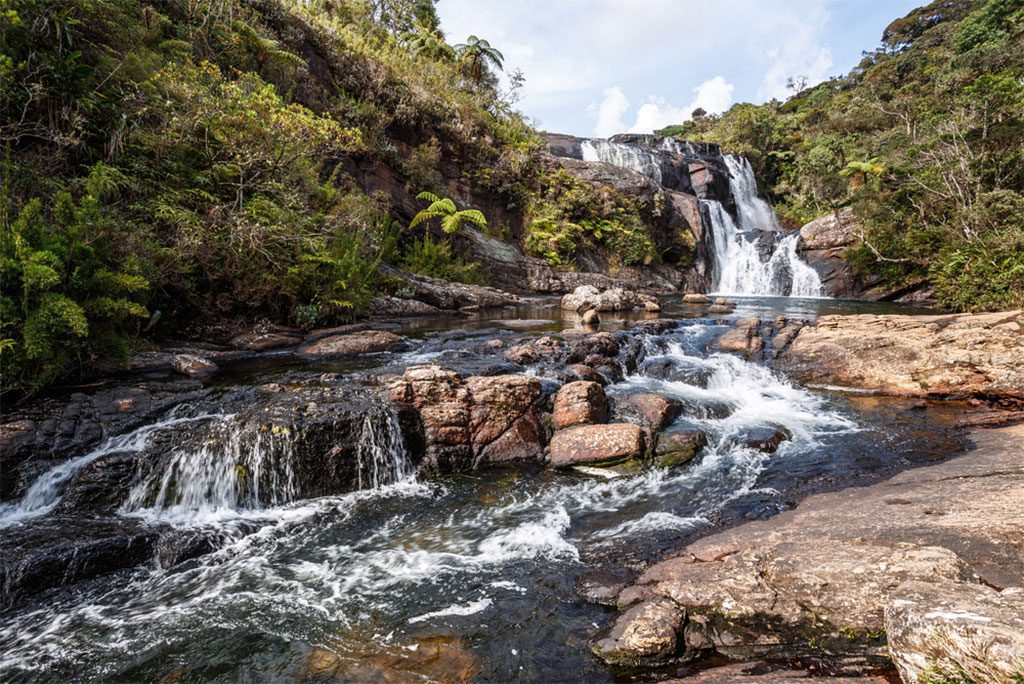
Baker’s Falls cascades down through the rocks in the scenic Horton Plains National Park, Sri Lanka. Image source: Travel landscapes/Shutterstock.com
Wow! Horton Plains is well worth a visit since it has many great lookouts over the park and its surroundings. The national park is located in the country’s central highlands, and its beautiful, thick forest gradually gives way to plateaus and peaks that rise above the skies.
The World’s End cliff is a popular destination because of the breathtaking views it provides. Horton Plains is home to a diverse array of plant and animal species because of its moist climate and proximity to the park’s three principal rivers.
Baker’s Falls, a lovely cascade emerging from the thick foliage, is another popular tourist destination. One of the most visited national parks in all of Sri Lanka, and with good reason.
1. Yala National Park
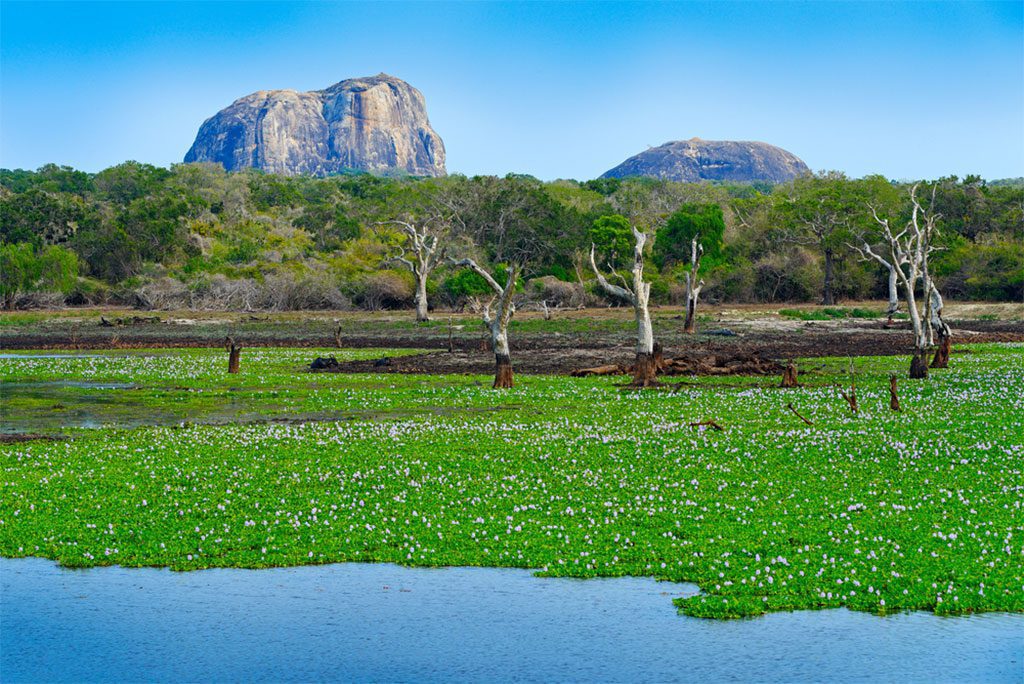
A leopard peers out from behind the bushes in the forest of Yala National Park, Sri Lanka. Image source: Ondrej Prosicky/Shutterstock.com
Seeing native Sri Lankan species like elephants and leopards in their natural habitat in the most popular national park in the country is a wonderful experience. Yala, in the country’s far south, is home to many different types of flora and fauna, with scenery that ranges from sandy beaches and thorn forests to grasslands and monsoon forests.
Visitors to the park could have the opportunity to see some of the world’s largest mammals, including a large population of elephants and one of the highest concentrations of leopards in the world. A multitude of historical civilizations formerly thrived in the Yala region of Sri Lanka, proving that history is never far away on the island. Sithulpahuwa and Magul Vihara, two important Buddhist pilgrimage sites, continue to draw many visitors to the park each year.


